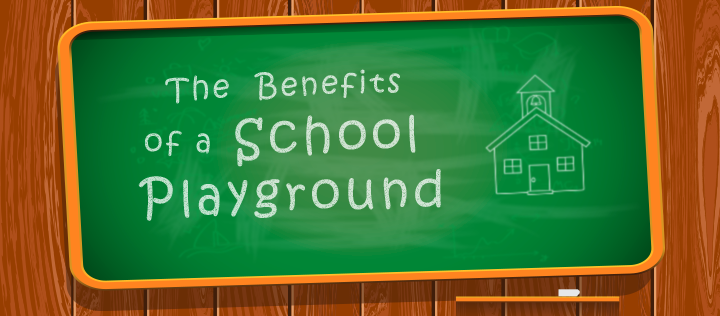The Benefits of a School Playground

Why was there ever a time where school boards felt the need to cut back on playground equipment and recess playtime? The shift in educational approach began in the 1980’s led by a belief that less play time would net a more academically focused child. Olga Jarrett and Sandra Waite-Stupiansky, members of Play, Policy, and Practice Interest Forum, explain the rationale in their column, “Recess—It’s Indispensable!” from the September 2009 issue of Young Children:
In the late 1980s, some school systems began cutting back on recess to allow more instructional time. The trend accelerated with the passage of No Child Left Behind in 2001 and was particularly widespread in urban schools with high numbers of children from marginalized populations(Jarrett 2003; Roth et al. 2003; NCES 2006).The arguments against recess involved both academics and safety issues. Some administrators believed their school’s test scores would improve if children spent more time on school work. Some feared lawsuits from playground injuries.
Educators and parents are now realizing that there is a greater intrinsic value to playtime or ‘recess’ during school. Providing the time, space, and equipment for children to explore enhances a variety of necessary cognitive and physical skills that support healthy child development.
One of the challenges for parents and educators is designating playtime—traditionally thought of as outdoor activities—versus computer or videogame applications. Studies have shown that children who enjoy less than one hour per day of ‘screen time’ (whether videogames or computer use) enjoy better peer relationships, academic performance, attentiveness, and an overall sense of wellbeing. The American Academy of Pediatrics recommends no more than two (2) hours of screen time per day.
Providing alternative activities for children provides a number of physical development and cognitive growth benefits. And whether on the school playground or a local playground, the equipment and activities provided are ideal for nourishing the need to move, learn and grow.
Exercise and Adventure on the School Playground
As an adult, when was the last time you attempted a span of horizontal bars using only your upper arm strength? Could you use the bars now? They are challenging and they are only one structural component of a playground that is designed to help children develop healthy muscles and other key physical abilities.
- Balance beams allow children to practice essential balance skills and coordination.
- Ladders and climbers teach children to coordinate hand and leg movements.
- Slides provide motivation for children to complete challenging vertical climbs to access the slide.
- Educational panels apply reasoning and logic skills, teaching children natural science, language or mechanical aptitudes.
Learning outdoors makes every exercise on the playground even more fun, because it provides kids with a sense of freedom to choose their activities and mode of play. That freedom and self-direction encourages repetition of exercises and mastery of certain skills; it makes it seem like play instead of learning, which requires little motivation for kids.
Exploration and Social Learning
Not everything on the playground is designed to provide physical skills development. Many playground structures are designed to encourage children to seek out cooperative group play.
- Tetherball games are the most fun with an opponent or with teams.
- See-saw structures need a second friend or peer to have fun.
- Tunnels (while an independent play activity) are most often shared experiences with friends.
- Tandem slides encourage children to race to the top (and bottom) and share a healthy competitive activity with friends.
- Tic-Tac-Toe panels and other games for two or more engage learning and play.
- Store Panels or Puppet Panels engage creative imaginations and group or independent play.
Learn more about the benefits of outdoor play on our previous post “The Link Between Play and Cognitive Development for Children,” or contact one of our play experts at 1-888-404-4416 to learn more about the importance of quality play structures at your school or local park.


